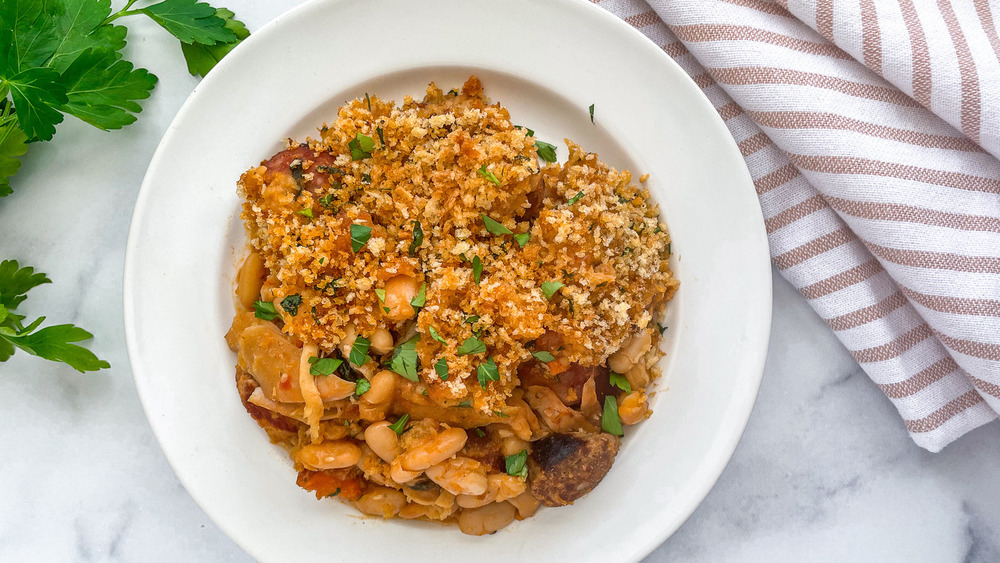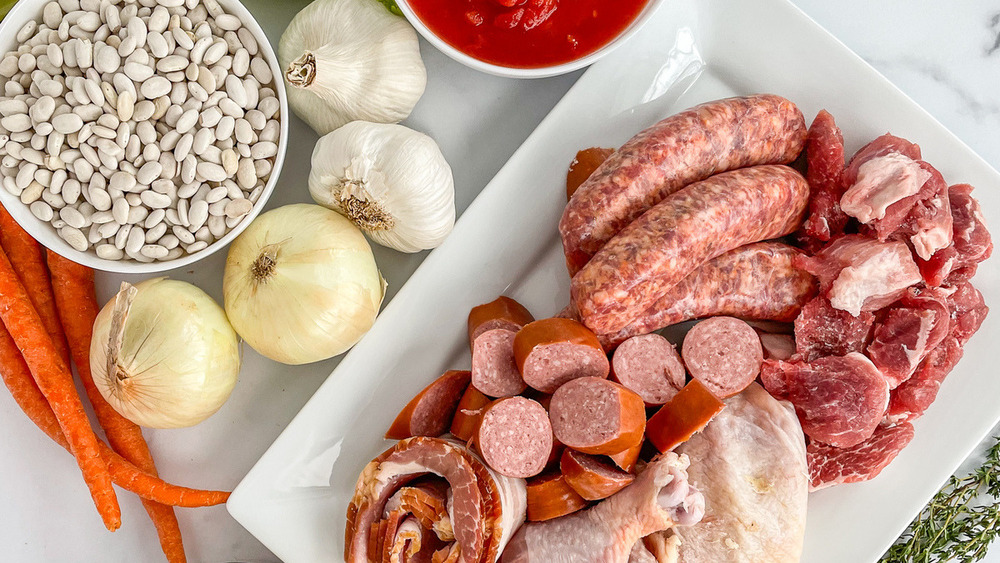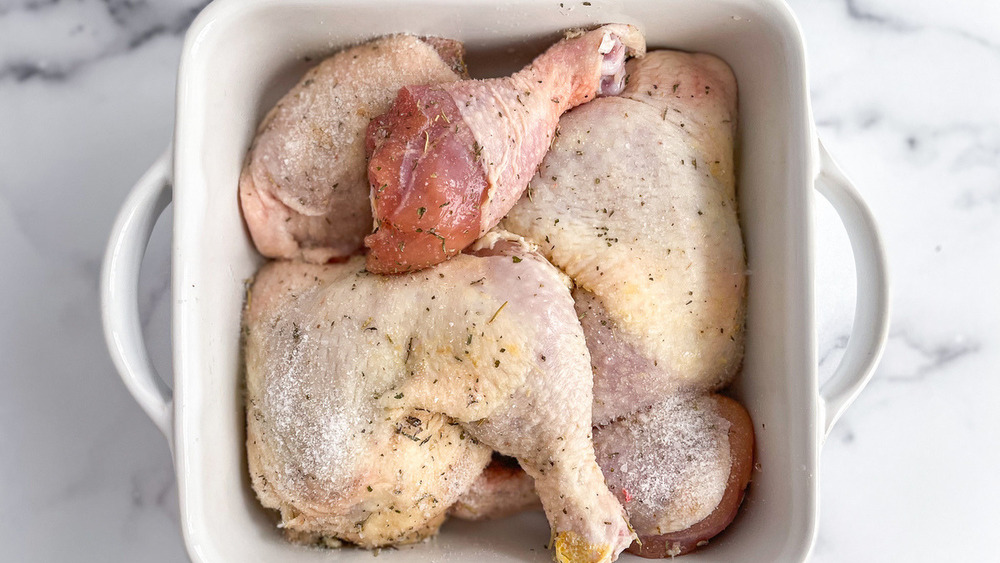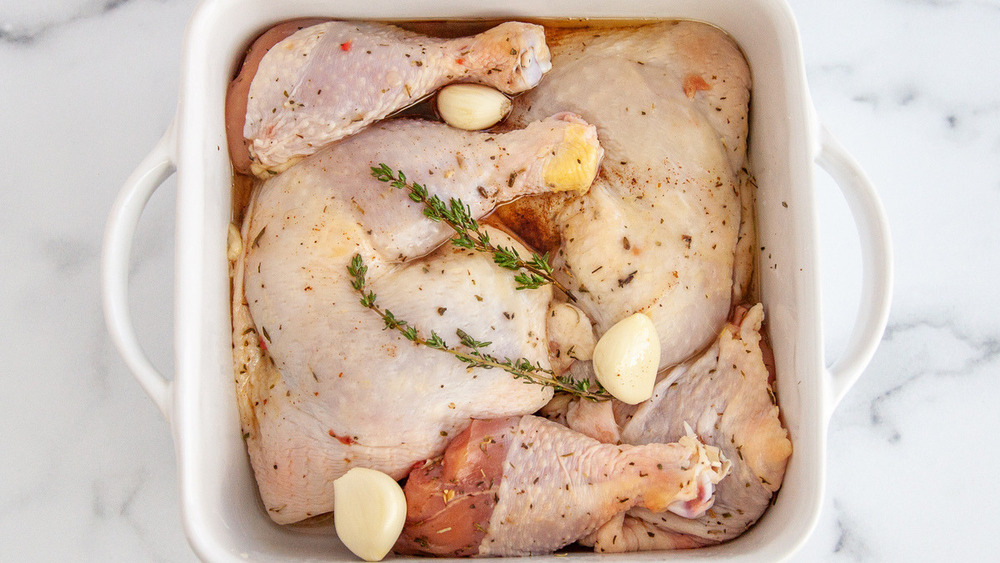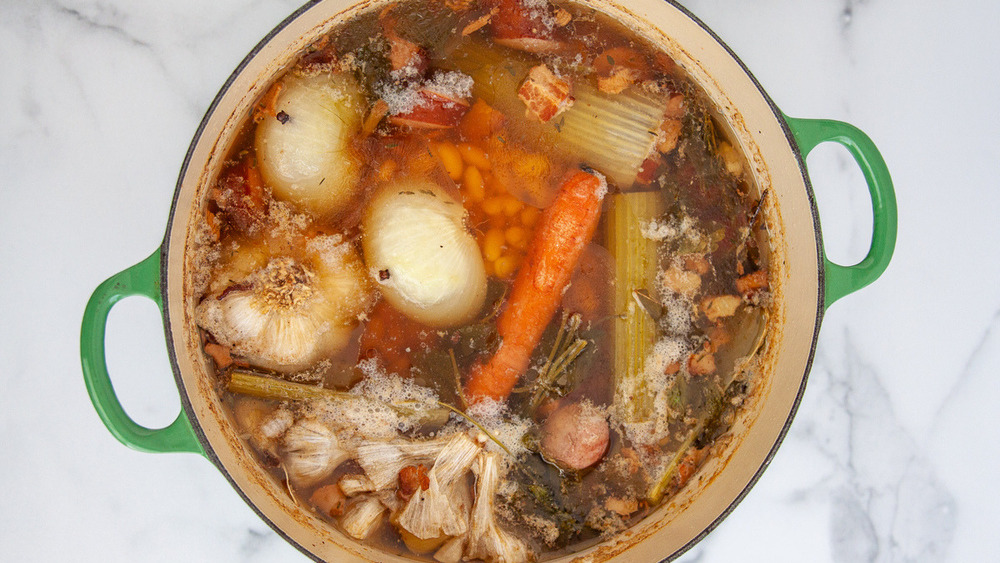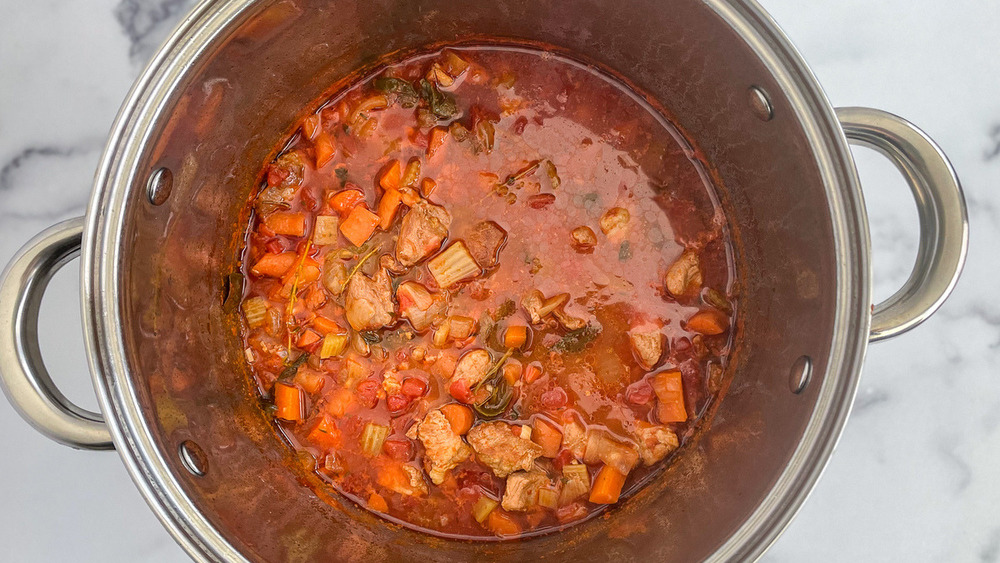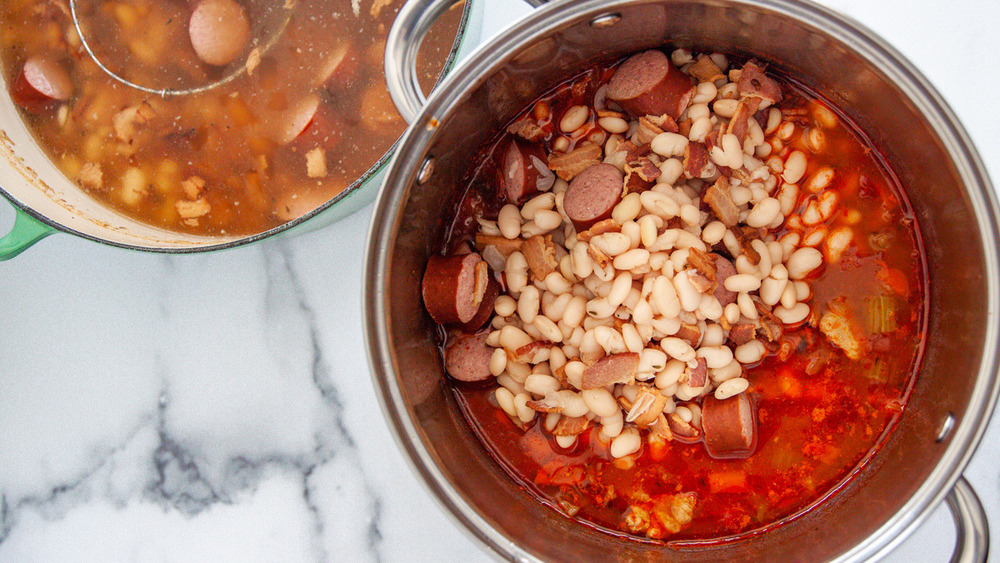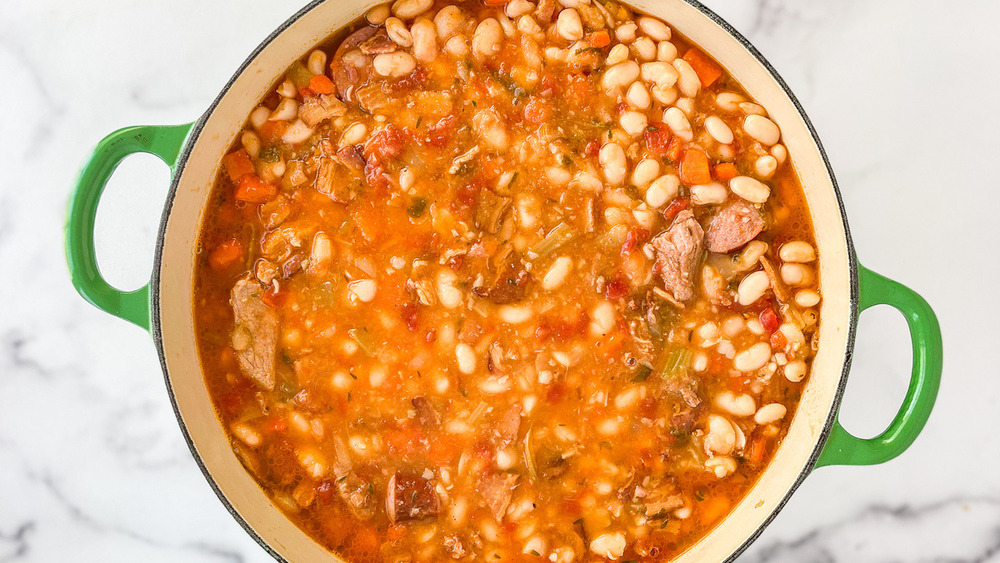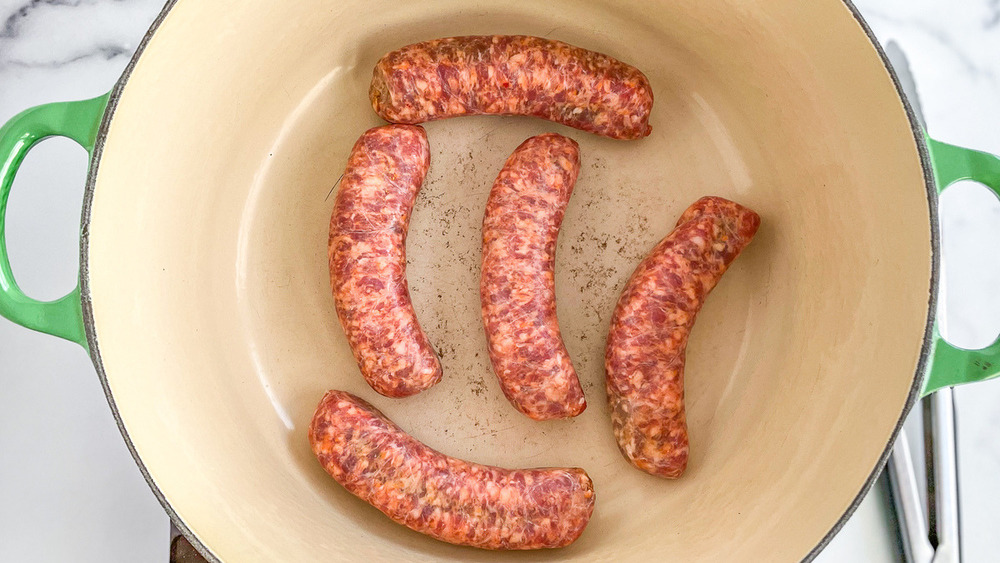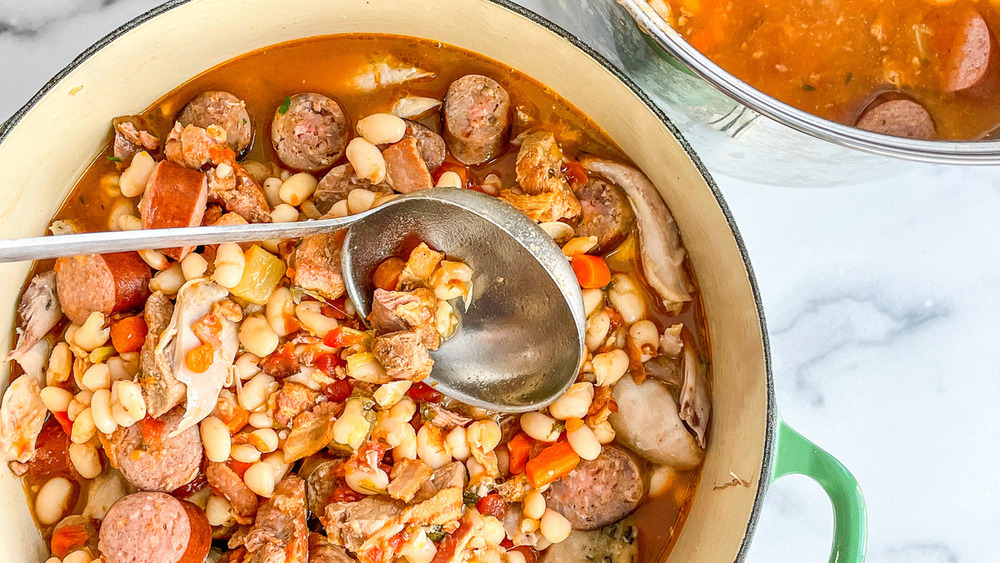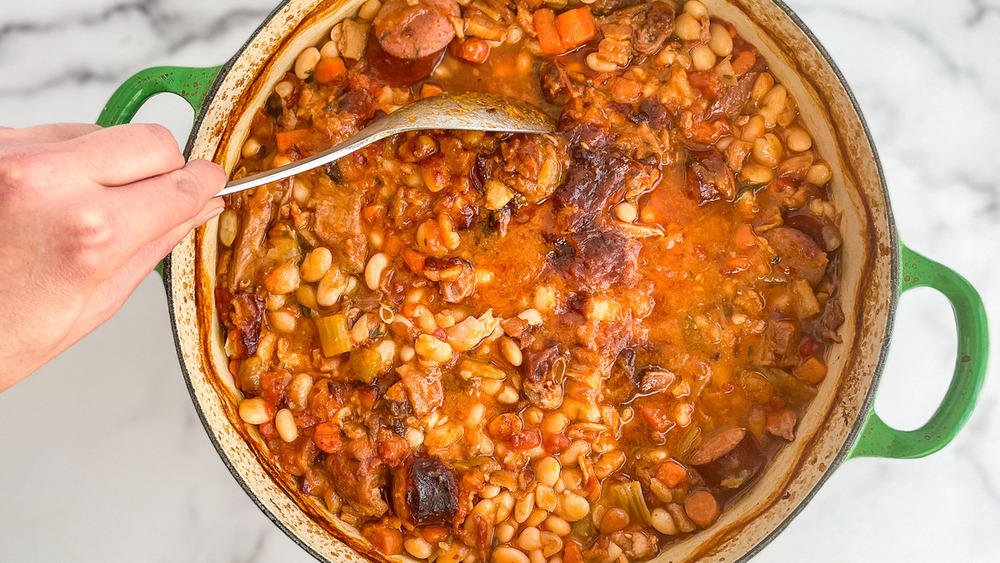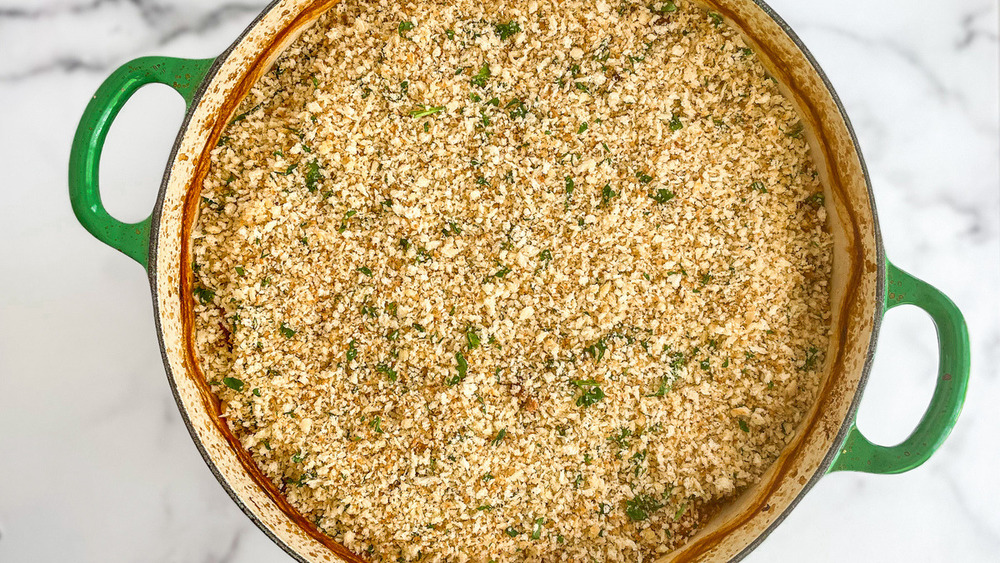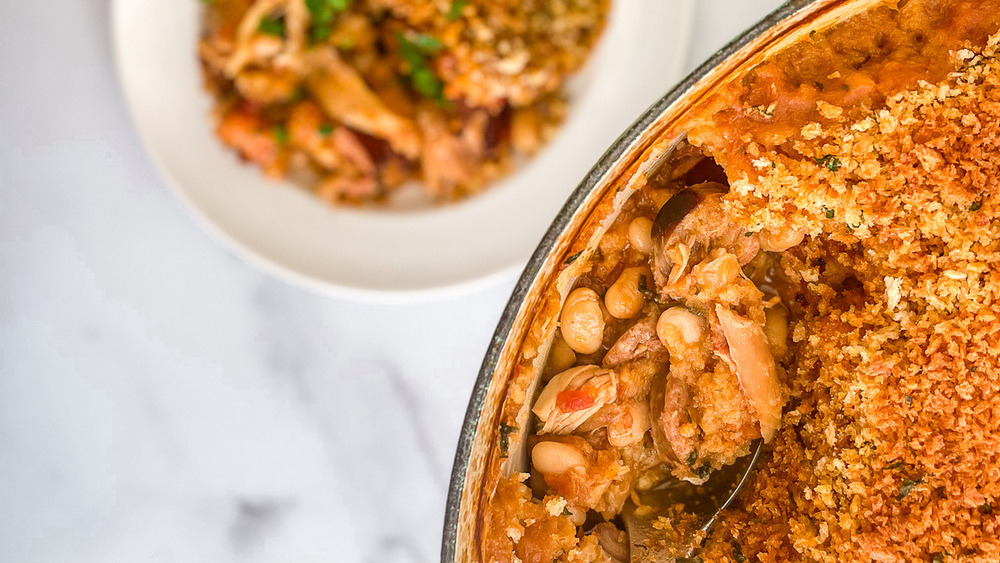Cassoulet Recipe
France is known for its hearty, flavorful dishes, from boeuf bourguignon to cheese fondue to cassoulet. If you haven't tried it before, cassoulet is a bean stew that's emblematic of France's southern region. It's combination of beans and several types of meat cooked low and slow until their flavors mix.
For recipe developer and food blogger Michelle Morey of Barefoot in the Pines, the key to success with this multi-component recipe is organization. "I would recommend taking the weekend to make it," she says. "So on Friday, brine the chicken and soak the beans. Saturday, roast the chicken, cook the beans, and the pork stew. Sunday, assemble and bake."
But, you don't need to make it all in one fell swoop, either. Morey notes that many of the components of this dish can be made days or weeks ahead of time and refrigerated or frozen until ready to reheat and use. With those shortcuts at the ready, the dish becomes easier to perfect. "The hands-on time is not long or tedious," says Morey. "In a nutshell, the home cook just needs to organize the steps and get as much prep done ahead of time, and they'll be all set!"
Gather the ingredients for cassoulet
The ingredients list for cassoulet is definitely hefty: four different forms of pork, poultry, the great northern beans that form the bulk of the dish, and a host of herbs and aromatics (including two heads of garlic), which create so much depth of flavor. In place of more traditional duck, Morey uses chicken legs in this recipe, which she says are "less intimidating" than duck for many home cooks. Plus, she notes, "It's less expensive, you get more meat from the chicken, and also you can find it easily at the grocery store."
Bacon, kielbasa, and fresh pork sausage stand in for more traditional pork belly and Toulouse sausage, adding a smoky aroma you'll love. "Both the smokiness from the bacon and the kielbasa add an extra layer of depth to the beans. This is important because essentially the cooking liquid from the beans is used as stock in the final dish. So, it needs to have as much flavor as possible," says Morey.
Two days ahead of serving, dry brine the chicken and soak the beans for the cassoulet
The process of preparing this cassoulet recipe begins two days before you plan to serve it with two important steps. First, soak the great northern beans by placing them into a large bowl and covering with enough cold water to cover by two inches. If you can't find great northern, cannelini or French Tarbais beans make a great substitute.
While your beans are soaking, it's time to turn your attention to the chicken, which will be dry brined. This is a simple step that basically ensures that the chicken is infused with flavor inside and out.
"Since we're not using duck or duck confit, I wanted to still replicate the elements of the duck with the chicken," says Morey. "So, the dry brining helps to salt the chicken inside and out, making it incredibly moist and flavorful."
A dry brine is also simpler and not nearly as messy as a wet one. Simply pat the chicken dry with paper towel and sprinkle with salt and herbs. Rub these seasonings into the skin and meat, cover loosely with plastic to ensure the chicken stays (true to form) dry, and chill 12 to 24 hours.
Slow-cook the chicken in bacon fat
The next day, when your beans have soaked and your chicken has brined, it's time to slow-cook the chicken, confit-style. First, preheat the oven to 300 degrees, and add three whole garlic cloves and thyme to your chicken. Let it sit while you cook the bacon, slowly rendering out all that delicious fat. Then, pour that luscious, smoky bacon grease over the chicken before covering and baking low and slow until pull-apart tender. This method emulates the duck confit traditionally used in this dish, which is slow-cooked in its own fat. Morey feels this essential step adds more salt and a deeper flavor to the finished product.
Once the chicken is cooked, remove it from the oven and allow it to cool before storing in the fridge until assembly day.
Cook the beans for the cassoulet
The pot you used to cook your bacon is now covered in a delightful fond, which will provide base flavors to the beans. First, discard the soaking liquid, which can apparently help reduce the digestive discomfort of consuming beans. Add them to the bacon pot along with the aromatics: a halved onion stuck with cloves, celery, carrots, and a whole head of garlic. Top with the kielbasa and cooked bacon, enough water to cover, and the herbs. Season with salt and pepper and bring to a boil, then reduce to a simmer and cook until tender.
Make the pork stew for the cassoulet
Next, it's time to make the pork stew with the Boston butt. Season the meat and dice the aromatics: onion, carrots, celery, and garlic. Then sear the pork until browned, working in batches to ensure that the pan isn't ever over-crowded, which would cause the pork to steam instead of sear and keep you from achieving that lovely, flavorful, caramelized crust.
Once all the pork has been seared, set it aside and add the aromatics, followed by the tomatoes, tomato paste, thyme, and bay. The pork and accumulated juices can then return to the pot, along with the chicken stock. Simmered for one and a half to two hours, this stew becomes tender and richly flavorful.
Combine the beans and pork stew for the cassoulet
When the beans and pork stew are both cooked and partially cooled, remove the aromatics: the onion, garlic, celery, bay, and herbs from the beans, and the thyme stems, parsley stems, and bay leaves from the pork stew. They've done their job and infused both components with tons of flavor, and you don't need them anymore.
Next, it's time to unite both components. Using a mesh spider or a slotted spoon, add the cooked beans to the pork stew mixture, seasoning to taste when everything is combined. Add cooking liquid to cover (or water if the mixture is very salty, thanks to the bacon).
Whatever you do, don't discard any excess cooking liquid! It's super flavorful and will be used later on. Just cover it — and cover the bean and pork mixture — until ready to assemble the next day.
Prepare the ingredients for assembling the cassoulet
The time has come: assembly day! Preheat the oven to 375 degrees Fahrenheit, and then grab your cooked chicken from the fridge to allow it to come up to room temperature. Remove the meat from the bones and skin, shredding all of that tender meat. Set aside, discarding the skin and bones.
Next, remove the pork and bean mixture from the fridge, skimming off any fat that will have solidified on the surface. Then, set the mixture over a medium-low heat and simmer until just heated through — not boiling — so that it's easy to scoop and layer with the other cassoulet components.
Cook the pork sausage for the cassoulet
Now, it's time for the final pork product to join the party: the pork sausages. Traditionally, Toulouse is the sausage of choice, but any seasoned sausage will do. Morey prefers sausages that are seasoned with garlic for even more flavor.
Cook the sausages over medium-low heat in a large Dutch oven, pricking them with a sharp knife to allow the fat to release and keep them from bursting. When nicely browned, remove from the pot and slice into ½-inch slices. Be sure to leave the fat and cooking juices in the Dutch oven — that's where you'll toast the panko for the cassoulet topping. (If there isn't enough fat to moisten the breadcrumbs, add a few tablespoons of olive oil to the mix). Toast until browned, and set aside with ¼ cup of chopped parsley.
Assemble the cassoulet
Now, it's time to assemble! Gather all your components: the pork and bean mixture, the shredded chicken confit, the sliced sausage, the Panko breadcrumbs, and the reserved cooking liquid from the beans, as well as the Dutch oven. To assemble, ladle ⅓ of the pork and bean mixture, topping with ½ of the chicken and ½ of the sausage. Top with the second third of pork and beans, followed by the remaining chicken and sausage. Finish with the remainder of the beans, and cover with enough bean cooking liquid (or water, if the pork and beans were very salty) to come to just the top of the beans. Do not fully submerge the beans — they should be poking out a little. Bake for an hour, or until a crust just starts to form and the edges are bubbling.
Break the crust of the cassoulet
At this point, a crust will have formed on top of the cassoulet. Remove the pot from the oven, and, using a spoon, gently pull open the crust and check to make sure liquid is pooling in the cracks you're making. If there is no liquid, add some of the reserved bean cooking liquid to moisten — a cup or so should be enough. Return the pot to the oven, and bake for another hour.
Add the breadcrumbs to the cassoulet
After the hour's up, it's time to repeat the crust-breaking. As before, add liquid as needed to keep the beans moist. Then, it's time to add the final layer: those crispy, bacon-infused, parsley-flecked breadcrumbs.
First, smooth out the top of the cassoulet to ensure you'll have even breadcrumb coverage. Then, sprinkle the breadcrumbs all over the top of the cassoulet. Bake 15 to 20 minutes more, until bubbly and golden brown.
Rest the cassoulet before serving
When the cassoulet emerges from the oven, it's going to be boiling hot. Give it 20 minutes to cool slightly and for the flavors to marry and mingle. This is the perfect time to think about side dishes: Morey suggests a simple green salad with a "zippy vinaigrette" to offset the hearty, heavy flavors of the cassoulet.
Once you've eaten your fill, you may find yourself with leftovers. To reheat these, Morey offers some options. "You can treat it like a casserole and bake in a baking dish, uncovered, in a low oven 325 or so until heated through," she suggests. "Add a couple of spoonfuls of warmed low sodium chicken stock to the casserole. And you can add some fresh breadcrumbs tossed in olive oil to the top for a fresh crunch."
That being said, this is not her favorite way to enjoy leftover cassoulet! "My favorite way to reheat is to turn this into a soup!" she says, noting that she scoops off any remaining breadcrumb topping before adding the leftover cassoulet to a saucepan.
"I add enough low sodium chicken stock to get the consistency I like and season with a little pepper and maybe add some fresh parsley and thyme if I have it on hand," she says. "Serve that with a side salad and you've got yourself a delicious meaty white bean soup."
Cassoulet
This hearty cassoulet is bursting with flavor. It's the ultimate recipe to prepare with a simple green salad for cozy nights in with the family.
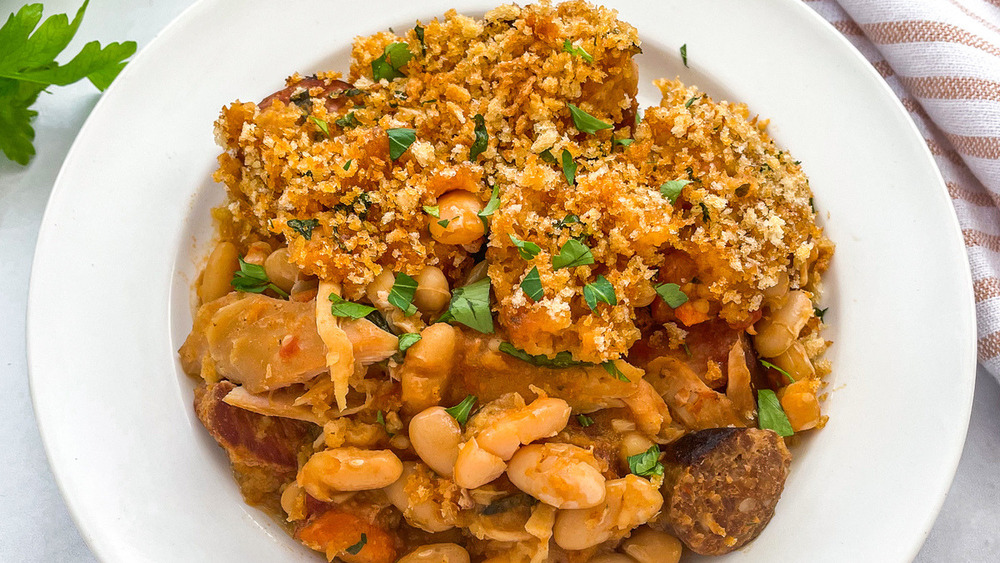
Ingredients
- 2 1/2 to 3 pounds chicken legs and thighs, bone-in, skin on
- 2 pounds Boston butt pork roast, bone removed, diced into 1-inch cubes
- 1 pound thick-cut uncured bacon, diced
- 14 ounces kielbasa sausage, cut into ½-inch slices
- 16 to 19 pounds fresh pork sausage, garlic preferred (mild Italian is a great sub)
- 1 pound dried great northern beans, rinsed
- 1 14-ounce can diced tomatoes
- 1 tablespoon tomato paste
- 6 cups low-sodium chicken stock
- 2 1/2 cups panko breadcrumbs
- 2 large white onions
- 5 large carrots
- 4 large stalks celery
- 2 heads garlic
- 1 bunch fresh thyme
- 1 bunch fresh parsley
- 4 bay leaves
- 2 whole cloves
- 1 teaspoon dried herbes de Provence
- olive oil
- kosher salt
- black pepper
Directions
- Two days ahead of serving, dry brine the chicken and soak the beans. To brine the chicken, pat the chicken dry with paper towels and sprinkle with 1 1/2 tablespoons of salt and 1 teaspoon of dried herbs de Provence. Rub into the skin and meat.
- Arrange chicken in an 8x8-inch baking dish and cover loosely with plastic wrap, leaving the corners of the dish uncovered. Refrigerate 12 to 24 hours.
- Next, rinse and drain the dried great northern beans. Put beans into a large bowl and cover with enough cold water to cover the beans by 2 inches. Soak overnight.
- The day before serving, cook the chicken, make the pork stew, and cook the beans. First, preheat the oven to 300 degrees Fahrenheit. Remove the salted chicken from the fridge and add 3 whole, peeled, garlic cloves and 2 sprigs of fresh thyme to the baking dish. Set aside.
- In a 7 to 8-quart Dutch oven or pot, cook the diced bacon over medium to medium-high heat until browned and crisp and a large amount of fat has been released. Turn off the burner to stop the cooking.
- Using a slotted spoon, remove the bacon from the pot and set it aside in a small dish. Do not wash the pot.
- Pour the bacon fat over the chicken, thyme, and garlic. Cover the baking dish with foil and roast the chicken at 300 degrees Fahrenheit until tender and falling off the bone, about 2 to 2 1/2 hours.
- Once the chicken is cooked, remove it from the oven and allow to cool completely. Pick the meat off the bone and away from the skin. Store in the fridge until assembly day.
- Drain the beans, discard the soaking liquid, and add them to the pot you cooked the bacon in.
- Peel and cut 1 large onion in half. Stick 1 whole clove into each onion half, and add that to the pot of beans along with 2 stalks of celery broken in half and 2 large carrots broken in half. Next, cut one whole head of garlic in half crosswise – do not peel it – and add it to the beans and vegetables. Finally, add the sliced kielbasa and add the bacon back to the pot. Add enough water to cover the beans by 2 inches, and add 4 to 6 sprigs of thyme, 6 sprigs of parsley, 2 bay leaves, 1 teaspoon of salt, and about 12 grinds of black pepper. Turn the heat up to high and bring to a boil.
- Once boiling, reduce the heat and simmer the pot of beans for about 45 minutes until the beans are just tender but still have a little bite. Remove the pot from the stove, skim off the foam if you desire, and let cool slightly.
- To make the pork stew, season the chunks of pork butt with 1 teaspoon of salt and a few cracks of pepper.
- Dice up one large onion (about 1 1/2 cups), 3 large carrots (about 1 1/2 cups), 2 stalks of celery (1 cup) and mince 3 cloves of garlic. Set aside.
- Heat 2 tablespoons of olive oil in a large pot over medium to medium-high heat. Working in batches, sear the pork until browned, but not cooked through. Remove the browned pork from the pot and transfer it to a plate. Continue until all of the pork has been browned, about eight to ten minutes per batch.
- Once all the pork has been seared and removed from the pot, add the diced carrots, onion, and celery to the pot and cook until soft, about two to three minutes. Add the minced garlic and cook for about 30 seconds, until fragrant. Add the diced tomatoes with their juice, 1 tablespoon of tomato paste, 4 sprigs of thyme, and 2 bay leaves. At this time, add the pork and any accumulated juices back to the pot. Add 6 cups of chicken stock and bring to a boil.
- Once boiling, reduce to a simmer and partially cover the pot with the lid. Simmer until the pork is tender, about 1 1/2 to 2 hours. Remove from the heat and let cool slightly.
- Once the beans and the pork stew have cooled a bit, remove the onion halves, garlic halves, carrots, celery, bay leaves, and herb stems from the beans. Discard. Next, remove any thyme stems, parsley stems, and bay leaves from the pork stew and discard.
- Using a mesh spider or a slotted spoon, add the cooked beans to the pork stew mixture. Once all the beans are combined with the pork stew, give the mixture a taste to check for saltiness. Add enough bean cooking liquid or water (if the mixture is very salty) to come to the top of the beans in the pot. Do not discard any unused bean cooking liquid -- store in the fridge to use later. Store the pork and bean mixture in the fridge overnight or up to two days.
- On the day of serving, assemble and bake the cassoulet. Preheat the oven to 375 degrees Fahrenheit, and move the oven rack to the middle position.
- Remove the cooked chicken from the fridge and allow it to come up to room temperature. If you haven't already done so, pick the meat away from the bones and skin at this point.
- Remove the pork and bean mixture from the fridge. Skim off the fat and warm up on the stovetop. Do this uncovered over low to medium-low heat, until the pork and beans are just steaming and heated through but not boiling.
- Add the fresh sausage to a large Dutch oven (7 to 8 quarts). Prick the links with a sharp knife to allow the fat to release and cook over medium to medium-low heat until cooked through. Remove the sausage to a cutting board and allow to cool. Once cool, slice into 1/2-inch slices. Do not clean out the pot after cooking the sausage.
- Add the panko breadcrumbs to the sausage fat and toss to coat. If the crumbs look dry or start to stick, add 2 to 3 tablespoons of olive oil and stir until well coated. Continue to toast over medium-low heat until the breadcrumbs until lightly browned.
- Remove the breadcrumbs from the Dutch oven and place them in a separate bowl. Do not wash out the pot. Add the ¼ cup chopped parsley to the panko, toss to combine, and set aside.
- Gather all of the cassoulet components: the pork and bean mixture, roasted chicken, sliced sausage, panko breadcrumbs, and additional cooking liquid from the beans. To assemble, ladle 1/3 of the pork and bean mixture into the Dutch oven. Next, layer on half of the roast chicken and sliced sausage. Add the second third of pork and beans and then layer with the remaining chicken and sausage. Top off the layers with the rest of the pork and bean mixture.
- Add enough bean cooking liquid (or water if the pork and beans were very salty) to come to just the top of the beans. Do not fully submerge the beans; they should be poking out a little.
- Place the Dutch oven, uncovered, into the oven, 375 degrees Fahrenheit. Bake for one hour, until a crust just starts to form and the sides are bubbling.
- Remove the pot from the oven, and using a spoon, gently pull open the crust and check to make sure liquid is pooling in the cracks you're making. If there is no liquid, add some of the reserved bean cooking liquid to moisten: a cup or so.
- Return the pot to the oven and bake for another hour.
- Remove the pot from the oven, break the crust with a spoon once more, and check to see if the beans are dry. If no liquid fills in the cracks, add another cup or so of cooking liquid. Smooth out the top of the cassoulet, and sprinkle on the breadcrumbs.
- Return to the oven and bake for 15 to 20 more minutes, until the edges are bubbling and the breadcrumbs are golden brown.
- Remove from the oven, and allow the cassoulet to sit for at least 20 minutes before serving.
